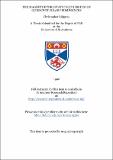Files in this item
The magnetohydrostatic equilibrium of quiescent solar prominences
Item metadata
| dc.contributor.advisor | Priest, E. R. (Eric Ronald) | |
| dc.contributor.author | Ridgway, Christopher | |
| dc.coverage.spatial | 132 p. | en_US |
| dc.date.accessioned | 2018-06-19T10:01:26Z | |
| dc.date.available | 2018-06-19T10:01:26Z | |
| dc.date.issued | 1992 | |
| dc.identifier.uri | https://hdl.handle.net/10023/14239 | |
| dc.description.abstract | Since the mid 1900's it has been supposed that the global magnetic field surrounding a quiescent prominence provides the force required to prevent its collapse under the influence of the Sun's gravitational field. Many theoretical models of this magnetic field have been produced in which it is assumed that the prominence plasma is supported in a dip in the field lines by the associated magnetic tension force. It is the aim of this thesis to propose further models of the magnetic field in order to extend our knowledge and understanding of prominences. In doing so we present three distinct models. The first is an extension of the twisted flux tube model for prominences proposed by Priest et al. (1989). Here we present analytical solutions to the magnetohydrostatic equilibrium equation within the tube using the so- called generating function method in which we select two distinct functional forms of the longitudinal field component. Unlike the solutions found by Priest et al., we allow for large deviations of the field from cylindrical symmetry. The prominence is represented by a finite vertical sheet of mass and current and we show that it is possible for such a sheet to be in static equilibrium everywhere along its vertical extent. Next we consider the model of van Ballegooijen and Martens in which photospheric motions drive a reconnection process leading to the formation of a helical magnetic structure capable of supporting dense prominence plasma in the low points of the helical windings. Under the assumption of cylindrical symmetry we analyse two methods of solving the magnetohydrostatic equilibrium equation in which the positions of the field line footpoints at the photosphere are imposed. Using a combination of analytical and numerical techniques, we study the quasi-static evolution of the model as the height of the helical axis increases. Unlike the numerical analysis of van Ballegooijen and Martens we are able to produce inverse polarity configurations without the problem of singular field components at the helical axis. Lastly we present an analysis of the interaction of a finite, vertical sheet of mass and current (representing a prominence) with an external constant-current force-free field. We formalise two distinct boundary-value problems in which the distribution of the normal magnetic field component along the photosphere is imposed along with the distribution of either the normal magnetic field component across the prominence or the prominence surface current. In both cases we demonstrate for particular boundary conditions that it is possible for equilibrium solutions to exist of both normal and inverse polarity in which dense material is supported everywhere along the prominence sheet. In particular we are, for the first time, able to produce an inverse polarity equilibrium configuration in which the field components are locally bounded and closed field lines exist above the prominence sheet while an X-type neutral point lies below it. | en_US |
| dc.language.iso | en | en_US |
| dc.publisher | University of St Andrews | en |
| dc.subject.lcc | QA927.R5 | |
| dc.subject.lcc | Magnetohydrodynamics | en |
| dc.title | The magnetohydrostatic equilibrium of quiescent solar prominences | en_US |
| dc.type | Thesis | en_US |
| dc.contributor.sponsor | Science and Engineering Research Council (SERC) | en_US |
| dc.type.qualificationlevel | Doctoral | en_US |
| dc.type.qualificationname | PhD Doctor of Philosophy | en_US |
| dc.publisher.institution | The University of St Andrews | en_US |
This item appears in the following Collection(s)
Items in the St Andrews Research Repository are protected by copyright, with all rights reserved, unless otherwise indicated.

